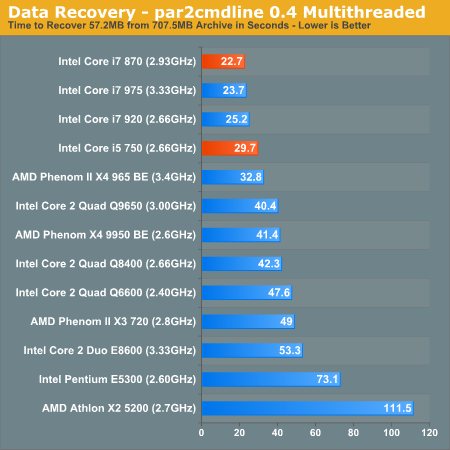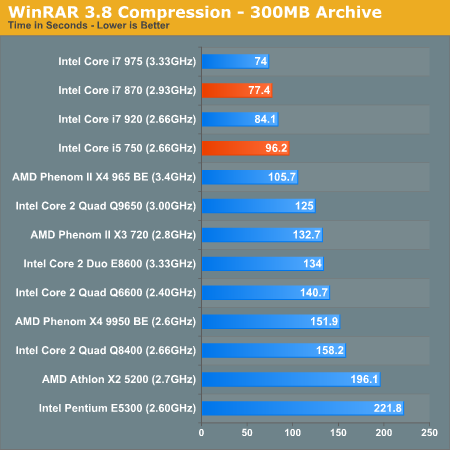Intel's Core i7 870 & i5 750, Lynnfield: Harder, Better, Faster Stronger
by Anand Lal Shimpi on September 8, 2009 12:00 AM EST- Posted in
- CPUs
PAR2 Multithreaded Archive Recovery Performance
Par2 is an application used for reconstructing downloaded archives. It can generate parity data from a given archive and later use it to recover the archive
Chuchusoft took the source code of par2cmdline 0.4 and parallelized it using Intel’s Threading Building Blocks 2.1. The result is a version of par2cmdline that can spawn multiple threads to repair par2 archives. For this test we took a 708MB archive, corrupted nearly 60MB of it, and used the multithreaded par2cmdline to recover it. The scores reported are the repair and recover time in seconds.

Faster than AMD? Check. Slower than the Core i7 920? Check. Costs under $200? Check. It's a shame that Intel didn't enable Hyper Threading on the Core i5 750, otherwise it would've really ruined most of the LGA-1366 lineup. The Core i7 860 is probably the best of both worlds unfortunately they are very hard to come by at this point.
The Core i7 870 is actually faster than the i7 975 here. I'll chalk that up to DDR3-1333 with some aggressive turboing.
WinRAR - Archive Creation
Our WinRAR test simply takes 300MB of files and compresses them into a single RAR archive using the application's default settings. We're not doing anything exotic here, just looking at the impact of CPU performance on creating an archive:

Large file compression is very well threaded and thus we see a real difference in performance between the HT enabled i7 920 and the i5 750 without Hyper Threading. The i7 870 however is within 5% of the i7 975, at 56% of the cost.










343 Comments
View All Comments
lordmetroid - Tuesday, September 8, 2009 - link
I am using Linux!andrenb91 - Wednesday, September 9, 2009 - link
c'mon probably u still running windows for somethings...wine doesn't work owith every thin...i run liux on dual boot for years and still trying to make wine run fligh simulator x..which is the only game I play...remember, these benchmarkes are only for win bases pcs, in linux the history is diferent, see it at phoronix.com...james jwb - Tuesday, September 8, 2009 - link
is turbo boost on for the benchmarks?snakeoil - Tuesday, September 8, 2009 - link
yes they benchmarked with turbo boost, that is cheating because thats overclocking the processor at least 600 mhz and presenting the results as it were at stock speeds.that's abusing the reader's trust.
maxxcool - Tuesday, September 8, 2009 - link
Hahaha, you are just as much of a idiot here as on techreport snake! ... did you come here and claim to have proof that i5 will not run xp-mode to?hahahaha, your just sad that Amd did not come up with this feature 1st.
Jarp Habib - Tuesday, September 8, 2009 - link
"yes they benchmarked with turbo boost, that is cheating because thats overclocking the processor at least 600 mhz and presenting the results as it were at stock speeds.that's abusing the reader's trust. "
This statement is a load of bullcrap. Anand's intent is to present the benchmarks in a way reflective of the chip's standard performance in normal use- hence not manually overclocking for maximized performance. The processor's very design revolves on itself automatically shutting down inactive cores and boosting the speed of active cores, *regardless* of what the end user does to the chip in BIOS or what apps he's running. Since all you need to do to use Turbo Boost is just *install the CPU in your system* then benchmarks should be run with it enabled.
If you want to COMPLETELY level the playing field, then TurboBoost should be shut down, for both Bloomfield i7 chips and Lynnfield i5 AND Lynnfield i7, as well as future i3 and i9. Also, HyperThreading must be disabled from all chips, 3DNow!, SpeedStep, Cool N' Quiet, MMX and the entire SSE instruction sets. After all, each different type of CPU executes those standard instruction sets differently. And since the SpeedStep and Cool N Quiet instructions force the chip to underclock and shut off cores while at idle, they must be eliminated from testing as well, or they'll throw off your idle power consumption benchmarks.
Since you will be normalizing the clock frequencies as well, you can save time by only needing to test just one chip from each product line. I'm not sure just how you will normalize the clock frequencies of your test units *without overclocking or underclocking* some of them though. Perhaps you'll let me know?
Meanwhile, back in the real world...
Voo - Tuesday, September 8, 2009 - link
The difference is, that turbo mode impairs the possible benefit of overclocking the chip, while most things you enumerated do not.If you want to get the maximum out of the 860 you've got to disable turbo mode as we see in the review, so for everyone who'd want to overclock their CPU the most interesting test would be a comparison between the two chips both at their maximum stable performance. Which at the moment means disabling turbo mode as we can see.
erple2 - Tuesday, September 8, 2009 - link
A-HA! So really, you're just interested in the benchmark "What does the maximum overclock do", not "How does the CPU perform at normal operations". BTW, does disabling HT does improve overclocking a little bit, so should that also be disabled? Cool-n-Quiet plus SpeedStep may also affect overclocking capabilities. Should those be disabled? I fail to see the difference between what the GP said and your justifications.MadMan007 - Tuesday, September 8, 2009 - link
I'm not bothered by enabled Turboboost in a 'stock speed' review either but I would really like to see more sites run their benchmark suite with 3.6-4.0GHz (or higher) C2D, C2Q and Phenom II versus overclocked but non-Turboboost i5/i7. The reason is that this type of comparison would be most directly useful for the site's enthusiast readerships to know what the actual difference between *their rig* and an i5/i7 would be.Kaleid - Thursday, September 10, 2009 - link
Seconded.